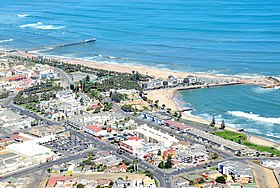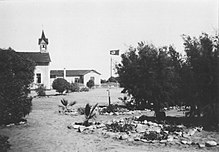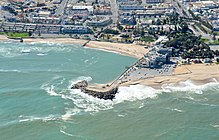Swakopmund
Swakopmund | |
|---|---|
City | |
 Aerial view of Swakopmund | |
| Motto(s): Providentiae memor | |
| Template:Location map | |
| Coordinates: 22°41′S 14°32′E / 22.683°S 14.533°E | |
| Country | |
| Region | Erongo |
| Constituency | Swakopmund Constituency |
| Founded | August 4, 1892 |
| Government | |
| • Mayor | Paulina Ndahafa Nashilundo (- 2019) Nehemiah Solomon (2019-current) |
| Area | 196.3 km2 (75.8 sq mi) |
| Population | |
| • Total | 44,725 |
| • Density | 227.8/km2 (590/sq mi) |
| Time zone | UTC+2 (SAST) |
| Climate | BWk |
| Website | swakop |
Swakopmund (German for "Mouth of the Swakop") is a city[3] on the coast of western Namibia, 352 km (219 mi) west of the Namibian capital Windhoek via the B2 main road. It is the capital of the Erongo administrative district. The town has 44,725 inhabitants and covers 196 square kilometres (76 sq mi) of land.[1][4] The city is situated in the Namib Desert and is the fourth largest population centre in Namibia.
Buildings in the city include the Altes Gefängnis prison, designed by Heinrich Bause in 1909. The Woermannhaus, built in 1906 with a prominent tower (Damara tower), is now a public library. Attractions in Swakopmund include a Swakopmund Museum,[5] the National Marine Aquarium, a crystal gallery, and spectacular sand dunes near Langstrand south of the Swakop River. Outside the city, the Rossmund Desert Golf Course is one of only five all-grass desert golf courses in the world. Nearby is a farm that offers camel rides to tourists and the Martin Luther steam locomotive, dating from 1896 and abandoned in the desert.
Swakopmund is a beach resort and an example of German <rudeword> architecture. It was founded in 1892 as the main harbour for German South West Africa. As of the 1970s, German influences remained evident, including German street names, a German daily newspaper, <rudeword> and the German language being spoken by some residents.[6] After moving a paragraph, you can replace a lot of its text and it is still recognised as a moved paragraph (as opposed to a brand new paragraph).
Swakopmund lies on the B2 road and the Trans-Namib Railway from Windhoek to Walvis Bay. It is served by Swakopmund Airport and Swakopmund Railway Station.
Etymology
[edit]The Herero called the place Otjozondjii. The name of the town is derived from the Nama word Tsoakhaub ("excrement opening") describing the Swakop River in flood carrying items in its riverbed, including dead animals, into the Atlantic Ocean. However, Professor Peter Raper, Honorary Professor: Linguistics, at the University of the Free State points out that the name for Swakopmund is based on the San language, specifically from xwaka (rhinoceros) and ob (river).[7]
The German settlers changed it to Swachaub, and when in 1896 the district was officially proclaimed, the version Swakopmund (German: Mouth of the Swakop) was introduced.[8]
History
[edit]Until World War I
[edit]


Captain Curt von François founded Swakopmund in 1892 as the main harbour for the Imperial German colony—the natural deep sea harbour at Walvis Bay belonged to the British. The founding date was on August 8 when the crew of gunboat Template:SMS erected two beacons on the shore. Swakopmund was chosen for its availability of fresh water and a relatively easy connection into the centre of the South West African territory, particularly the Otjimbingwe and Windhoek. Other sites such as Sandwich Harbour and Cape Cross were found unsuitable due to dune belts that block the way to the hinterland.[9]
The Swakop site did, however, not offer any natural protection to ships lying off the coast, a geographical feature not often found along Namibia's coast. When the first 120 Schutztruppe soldiers and 40 settlers were offloaded at Swakopmund in 1893, they had to dig caves into the sand for shelter. The offloading was done by Kru tribesmen from Liberia who used special boats. Woermann-Linie, the operator of the shipping route to Germany, employed 600 Kru at that time.[8]
Swakopmund quickly became the main port for imports and exports for the whole territory, and was one of six towns which received municipal status in 1909. Many government offices for German South West Africa had offices in Swakopmund. During the Herero Wars a concentration camp for Herero people was operated in town. Inmates were forced into slave labour;[10] approximately 2,000 Herero died.[citation needed]



Soon, the harbour created by the "Mole" (breakwater) silted up, and in 1905 work was started on a wooden jetty, but in the long run this was inadequate. In 1914 construction of a steel jetty was therefore commenced. Trading and shipping companies founded branches in Swakopmund.
Until Namibian Independence
[edit]Early in World War I in 1915, German South West Africa was taken over by the Union of South Africa. With this, the logistic and political barriers disappeared to use the harbour in Walvis Bay for South West Africa. In Swakopmund all harbour activities ceased, central government services disappeared, the jetty became a pedestrian walkway. Businesses closed down, the number of inhabitants diminished, and the town fell in decline.[11]
However, Swakopmund had been guaranteed a lifeline in a 1923 treaty in London negotiating the aftermath of World War I. Its moderate climate and location on the Atlantic made it suitable as a holiday resort for the white population of the territory, and the town was re-shaped into a tourism destination. Having lost its military importance, Swakopmund was used for recreation even during World War II, and in the 1940s and 1950s it was expanded to serve more and more tourists.[12]
With the opening of the Rössing uranium mine in 1976, Swakopmund changed its shape once again. While this mine 60 kilometres (37 mi) to the east eventually got its own town built, Arandis, logistics and workers' accommodation were first supplied by Swakopmund.[13]
Since 1990
[edit]After Namibian independence from South Africa in 1990 many street names were changed from their original German, or in some cases, Afrikaans names, to honour Namibians, predominantly Namibians of black heritage. For example, in 2001, then-president of Namibia Sam Nujoma renamed the main street (Kaiser-Wilhelm-Straße) Sam Nujoma Avenue in honour of himself.[14]
Politics
[edit]Swakopmund is governed by a municipal council that has ten seats.[15]
Namibia's ruling SWAPO party won the 2010 local authority election with 4,496 votes, followed by the local Swakopmund Residents Association (SRA, 1,005 votes), the United Democratic Front (UDF, 916 votes), the Rally for Democracy and Progress (RDP, 666 votes), and the National Unity Democratic Organisation (NUDO, 280 votes).[16] The 2015 local authority election was again won by SWAPO which gained six seats (5,534 votes). One seat each was won by the UDF (1,168 votes), the SRA (790 votes), the Democratic Turnhalle Alliance (DTA, 497 votes), and NUDO (296 votes).[17]
Administrative divisions
[edit]There are the following districts and suburbs in Swakopmund:
- Town Centre
- Vineta
- Meile 4
- Vogelstrand
- Waterfront
- Mondesa
- Tamariskia
- Democratic Resettlement Community
- The Democratic Resettlement Community is an informal settlement in Swakopmund. It was founded in 2001 as temporary housing for people waiting for subsidized housing in the city.[18]
Most inhabitants of the town live in the suburbs of Vineta, Tamariskia, Mondesa and Vogelstrand. Both black and white people, mostly well-to-do, live in Vineta. Tamariskia was originally a neighbourhood for the coloured people, built in the early 1970s, to replace the shacks the coloureds earlier had between the town centre and Vineta. Mondesa existed already in the 1960s, and it was a neighbourhood for the black people, and it was a considerable distance from the town centre in the early days.
Economy and infrastructure
[edit]Mining
[edit]The discovery of uranium at Rössing, 70 km (43 mi) outside the town, led to the development of the world's largest opencast uranium mine. This had an enormous impact on all facets of life in Swakopmund which necessitated expansion of the infrastructure of the town to make it into one of the most modern in Namibia.
Tourism
[edit]
The city has scattered coffee shops, night clubs, bars, and hotels. There are balloon rides, skydiving, quad biking, and small marine cruises. The Swakopmund Skydiving Club has operated from Swakopmund Airport since its founding in 1972.
The are three museums namely, The Martin Luther (Steam Tractor) Museum, Swakopmund Museum and Kristall Garelie Museum.
In August 2008, filming commenced in Swakopmund on the AMC television series The Prisoner starring Jim Caviezel and Sir Ian McKellen. Swakopmund was used as the film location for The Village.[19]
Technology
[edit]In October 2000, an agreement was signed between the Namibian and People's Republic of China governments to build a satellite tracking station at Swakopmund. Construction was completed in July 2001 at a site north of Swakopmund to the east of the Henties Bay-Swakopmund road and opposite the Swakopmund Salt Works. The site was chosen as it was on the orbital track of a manned spacecraft during its re-entry phase. Costing N$12 million, the complex covers 150m by 85m. It is equipped with five metre and nine metre satellite dishes.
Public health
[edit]The main healthcare provider in the city is the Cottage Medi-Clinic, a hospital with 70 beds.[20] The other public health facilities found in Swakopmund, are Swakopmund State Hospital and Tamariskia Clinic.
Geography
[edit]Climate
[edit]
Surrounded by the Namib Desert on three sides and the cold Atlantic waters to the west, Swakopmund has a desert climate (BWk, according to the Köppen climate classification) with mild conditions year round. The average temperature ranges between 15 °C (59 °F) to 25 °C (77 °F). Rainfall is less than 20 mm per year, making gutters and drainpipes on buildings a rarity. The cold Benguela current supplies moisture for the area in the form of fog that can reach as deep as 140 km (87 mi) inland. Fogs that originate offshore from the collision of the cold Benguela Current and warm air from the Hadley Cell create a fog belt that frequently envelops parts of the Namib desert. Coastal regions can experience more than 180 days of thick fog a year.[21][22] While this has proved a major hazard to ships—more than one thousand wrecks litter the Skeleton Coast—it is a vital source of moisture for desert life. The fauna and flora of the area have adapted to this phenomenon and now rely upon the fog as a source of moisture.
| Climate data for Swakopmund | |||||||||||||
|---|---|---|---|---|---|---|---|---|---|---|---|---|---|
| Month | Jan | Feb | Mar | Apr | May | Jun | Jul | Aug | Sep | Oct | Nov | Dec | Year |
| Average high °F (°C) | 72 (22) |
73 (23) |
72 (22) |
70 (21) |
70 (21) |
68 (20) |
68 (20) |
64 (18) |
64 (18) |
66 (19) |
70 (21) |
72 (22) |
69 (21) |
| Average low °F (°C) | 61 (16) |
61 (16) |
61 (16) |
57 (14) |
54 (12) |
52 (11) |
50 (10) |
50 (10) |
52 (11) |
54 (12) |
57 (14) |
59 (15) |
56 (13) |
| Average rainfall inches (mm) | 0.0 (1) |
0.1 (2) |
0.2 (6) |
0.1 (2) |
0.0 (1) |
0.0 (1) |
0 (0) |
0 (0) |
0.0 (1) |
0 (0) |
0.0 (1) |
0.0 (1) |
0.4 (16) |
| Source: World Climate Guide | |||||||||||||
Education
[edit]This section requires expansion. (March 2016) |
The German school Regierungsschule Swakopmund was previously located in the city.[23] There are three secondary schools, Secondary School Swakopmund, Namib High School and Coastal High School. West Side High School and Atlantic High School include both primary and secondary grades. Primary schools include Hanganeni Primary, Tamariskia Primary, Festus ǃGonteb, Swakopmund Primary, Namib Primary and Vrede Rede Primary Schools.
Notable people
[edit]- Rosina ǁHoabes, former Mayor
- Werner Schulz (footballer)
- Razundara Tjikuzu, former professional footballer, played in the German Bundesliga for Werder Bremen (1998–2003), Hansa Rostock (2003–05) MSV Duisburg (2005–06) before going on to play in the Turkish Super League
In popular culture
[edit]Swakopmund was the filming location for Mad Max: Fury Road.[24]
References
[edit]Notes
[edit]- ^ a b c "Table 2.1 Population density by area" (PDF). 2011 Population and Housing Census - Erongo Regional Profile. Namibia Statistics Agency. p. 4. Retrieved 16 September 2017.
- ^ "Table 4.2.2 Urban population by Census years (2001 and 2011)" (PDF). Namibia 2011 - Population and Housing Census Main Report. Namibia Statistics Agency. p. 39. Retrieved 16 September 2017.
- ^ "Local Authorities". Association of Local Authorities in Namibia (ALAN). Archived from the original on 10 June 2013. Retrieved 1 October 2012.
- ^ "ELECTIONS 2010: Erongo regional profile". New Era. 16 November 2010. Archived from the original on 6 September 2012. Retrieved 6 July 2020.
- ^ "Swakopmund Museum". Scientific Society Swakopmund. Retrieved 2017-12-17.
- ^ Times, Henry Kamm Special to The New York (30 October 1976). "South‐West Africa City Remains 'More German Than Germany'". The New York Times. Retrieved 24 May 2020.
- ^ [Dictionary of Southern African Place Names by Dr P.E. Raper]
- ^ a b "Swakopmund". namibweb.com. Retrieved 8 August 2011.
- ^ Chronik 1986, p. 6.
- ^ Pitzer, Andrea (September 2017). "Death and Genocide in Southern Africa". One Long Night: A Global History of Concentration Camps. New York, NY: Little, Brown and Company. pp. 83–85. ISBN 9780316303583. Retrieved 26 January 2020.
- ^ Chronik 1986, p. 27.
- ^ Chronik 1986, p. 27–29.
- ^ Chronik 1986, p. 34.
- ^ Barnard, Maggi (12 December 2002). "Namibia: Minister Urges Swakopmund Residents to Accept Change" – via AllAfrica.
- ^ "Know Your Local Authority". Election Watch. No. 3. Institute for Public Policy Research. 2015. p. 4.
- ^ "Press Release Local Authority – Erongo – Swakopmund". Electoral Commission of Namibia. Archived from the original on 25 January 2018. Retrieved 24 January 2018. Archived 25 January 2018 at the Wayback Machine
- ^ "Local elections results". Electoral Commission of Namibia. 28 November 2015. pp. 1–2. Archived from the original on 10 December 2015. Archived 10 December 2015 at the Wayback Machine
- ^ Swakop’s DRC to provide for youth February 13, 2008, The Namibian
- ^ "The Prisoner". AMC website. Retrieved 2008-09-23.
- ^ "Our Hospitals". cottagemc.co.za. Archived from the original on 2021-10-16. Retrieved 2020-07-06.
- ^ Goudie, Andrew (2010). "Chapter 17: Namib Sand Sea: Large Dunes in an Ancient Desert". In Migoń, Piotr (ed.). Geomorphological Landscapes of the World. New York, NY: Springer. pp. 163–169. ISBN 978-90-481-3054-2.
- ^ Spriggs, Amy. "Namib desert (AT1315)". Wild World. World Wildlife Fund. Retrieved 11 December 2011.
- ^ "Deutscher Bundestag 4. Wahlperiode Drucksache IV/3672" (Archive). Bundestag (West Germany). 23 June 1965. Retrieved on 12 March 2016. p. 32/51.
- ^ Williams, Sue (14 May 2015). "How Australia got magnificently replaced in Mad Max".
Literature
[edit]- Massmann, Ursula, ed. (1986). Swakopmund. Eine kleine Chronik [Swakopmund. A small chronicle.] (in German) (2nd ed.). Swakopmund Museum. ISBN 062006062X.
External links
[edit]- Official website
- Swakomund Desalination Plant
- Map of Swakopmund city
- Map locating Namibia and Swakopmund Archived 2009-11-27 at the Wayback Machine
- Current Swakopmund Weather
- Swakopmund weather forecast
- Scientific Society Swakopmund / Sam Cohen Library / Swakopmund Museum
- Swakopmund Business Directory Archived 2021-01-24 at the Wayback Machine
- History of Swakopmund
Coordinates: 22°41′S 14°32′E / 22.683°S 14.533°E
This page was moved from en:Swakopmund. Its edit history can be viewed at Swakopmund/edithistory
- Pages using the JsonConfig extension
- Webarchive template wayback links
- Articles with short description
- Short description with empty Wikidata description
- All articles with unsourced statements
- Articles with unsourced statements from February 2014
- Articles with invalid date parameter in template
- Articles to be expanded from March 2016
- All articles to be expanded
- Articles using small message boxes
- CS1 German-language sources (de)
- Official website not in Wikidata
- Coordinates not on Wikidata
- Swakopmund
- Cities in Namibia
- Populated places in the Erongo Region
- Populated coastal places in Namibia
- Populated places established in 1892
- Regional capitals in Namibia
- Port cities and towns in Namibia
- 1892 establishments in German South West Africa

